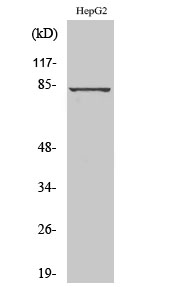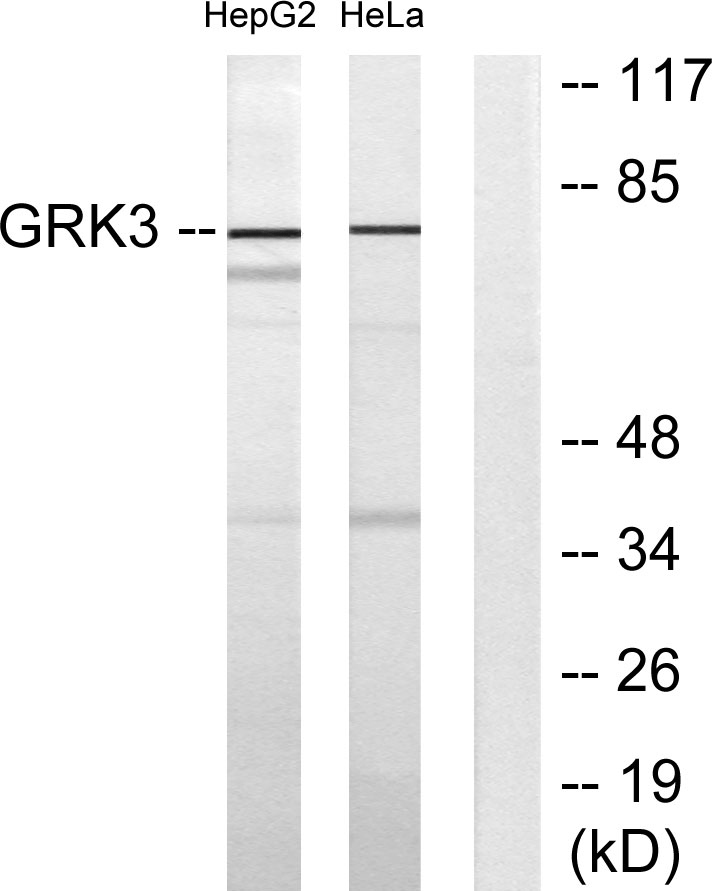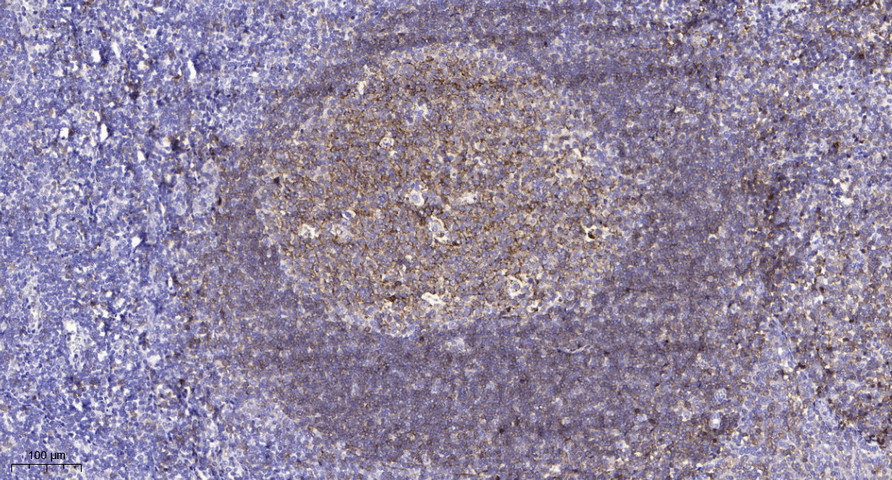GRK 3 Polyclonal Antibody
- Catalog No.:YT2068
- Applications:WB;IHC;IF;ELISA
- Reactivity:Human;Mouse;Rat
- Target:
- GRK 3
- Fields:
- >>Chemokine signaling pathway;>>Endocytosis;>>Hedgehog signaling pathway;>>Glutamatergic synapse;>>Olfactory transduction;>>Morphine addiction
- Gene Name:
- ADRBK2
- Protein Name:
- Beta-adrenergic receptor kinase 2
- Human Gene Id:
- 157
- Human Swiss Prot No:
- P35626
- Mouse Gene Id:
- 320129
- Mouse Swiss Prot No:
- Q3UYH7
- Rat Gene Id:
- 25372
- Rat Swiss Prot No:
- P26819
- Immunogen:
- The antiserum was produced against synthesized peptide derived from human GRK3. AA range:361-410
- Specificity:
- GRK 3 Polyclonal Antibody detects endogenous levels of GRK 3 protein.
- Formulation:
- Liquid in PBS containing 50% glycerol, 0.5% BSA and 0.02% sodium azide.
- Source:
- Polyclonal, Rabbit,IgG
- Dilution:
- WB 1:500 - 1:2000. IHC 1:100 - 1:300. ELISA: 1:20000.. IF 1:50-200
- Purification:
- The antibody was affinity-purified from rabbit antiserum by affinity-chromatography using epitope-specific immunogen.
- Concentration:
- 1 mg/ml
- Storage Stability:
- -15°C to -25°C/1 year(Do not lower than -25°C)
- Other Name:
- ADRBK2;BARK2;GRK3;Beta-adrenergic receptor kinase 2;Beta-ARK-2;G-protein-coupled receptor kinase 3
- Observed Band(KD):
- 80kD
- Background:
- The beta-adrenergic receptor kinase specifically phosphorylates the agonist-occupied form of the beta-adrenergic and related G protein-coupled receptors. Overall, the beta adrenergic receptor kinase 2 has 85% amino acid similarity with beta adrenergic receptor kinase 1, with the protein kinase catalytic domain having 95% similarity. These data suggest the existence of a family of receptor kinases which may serve broadly to regulate receptor function. [provided by RefSeq, Jul 2008],
- Function:
- catalytic activity:ATP + [beta-adrenergic receptor] = ADP + [beta-adrenergic receptor] phosphate.,function:Specifically phosphorylates the agonist-occupied form of the beta-adrenergic and closely related receptors.,similarity:Belongs to the protein kinase superfamily.,similarity:Belongs to the protein kinase superfamily. AGC Ser/Thr protein kinase family. GPRK subfamily.,similarity:Contains 1 AGC-kinase C-terminal domain.,similarity:Contains 1 PH domain.,similarity:Contains 1 protein kinase domain.,similarity:Contains 1 RGS domain.,
- Subcellular Location:
- Cell junction, synapse, postsynapse . Cell junction, synapse, presynapse .
- Expression:
- Brain,Ovary,
- June 19-2018
- WESTERN IMMUNOBLOTTING PROTOCOL
- June 19-2018
- IMMUNOHISTOCHEMISTRY-PARAFFIN PROTOCOL
- June 19-2018
- IMMUNOFLUORESCENCE PROTOCOL
- September 08-2020
- FLOW-CYTOMEYRT-PROTOCOL
- May 20-2022
- Cell-Based ELISA│解您多样本WB检测之困扰
- July 13-2018
- CELL-BASED-ELISA-PROTOCOL-FOR-ACETYL-PROTEIN
- July 13-2018
- CELL-BASED-ELISA-PROTOCOL-FOR-PHOSPHO-PROTEIN
- July 13-2018
- Antibody-FAQs
- Products Images

- Western Blot analysis of various cells using GRK 3 Polyclonal Antibody diluted at 1:500

- Western blot analysis of lysates from HepG2 and HeLa cells, using GRK3 Antibody. The lane on the right is blocked with the synthesized peptide.

- Western blot analysis of the lysates from K562 cells using GRK3 antibody.

- Immunohistochemical analysis of paraffin-embedded human tonsil. 1, Antibody was diluted at 1:200(4° overnight). 2, Tris-EDTA,pH9.0 was used for antigen retrieval. 3,Secondary antibody was diluted at 1:200(room temperature, 45min).



